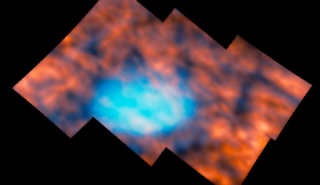England-size pixels help astronomers find new Jupiter shape
27 June 2024
 Using the largest and most powerful telescope ever launched into space, scientists including a University of Reading astronomer have discovered a variety of previously unseen features on and around Jupiter’s iconic Great Red Spot. The region, previously believed to be unremarkable in nature, hosts a variety of intricate structures and activity.
Using the largest and most powerful telescope ever launched into space, scientists including a University of Reading astronomer have discovered a variety of previously unseen features on and around Jupiter’s iconic Great Red Spot. The region, previously believed to be unremarkable in nature, hosts a variety of intricate structures and activity.
Jupiter is one of the brightest objects in the night sky, and it is easily seen on a clear night. Aside from the bright northern and southern lights at the planet’s polar regions, the glow from Jupiter’s upper atmosphere is weak and is therefore challenging for ground-based telescopes to discern details in this region.
However, the NASA/ESA/CSA James Webb Space Telescope infrared sensitivity allowed scientists to study Jupiter’s upper atmosphere above the infamous Great Red Spot with unprecedented detail.
The Great Red Spot of Jupiter was observed by Webb’s Near-InfraRed Spectrograph (NIRSpec) in July 2022, using the instrument’s Integral Field Unit capabilities. The team’s observations sought to investigate if this region was in fact dull, and the region above the iconic Great Red Spot was targeted for Webb’s observations.
The team discovered that the upper atmosphere hosts a variety of intricate structures, including dark arcs and bright spots, across the entire field of view. These results have been published in Nature Astronomy.
Dr James O’Donoghue, the University of Reading astronomer who contributed to the study, said: “Using the James Webb Space Telescope, we observed Jupiter's upper atmosphere, focusing on regions high above the Great Red Spot. At altitudes more than a thousand miles above Jupiter's clouds, we discovered remarkable, previously unseen details: bright emission spots and massive atmospheric bands comparable in size to the UK's length and Russia's width. 
“Our study argues these complex, overlapping structures are atmospheric gravity waves, propelled by extremely windy weather layers below. Previous observations lacked the resolution to detect these features, with pixels covering areas as large as Africa. Our breakthrough comes from achieving England-sized pixels, allowing us to study these waves for the first time and probe Jupiter's upper atmospheric weather in unprecedented detail.”
Lead author, Henrik Melin of the University of Leicester, said: “We thought this region, perhaps naively, would be really boring. It is in fact just as interesting as the northern lights, if not more so. Jupiter never ceases to surprise.”
The atmospheric waves can be observed on Earth on occasion, however, they are much weaker than those observed on Jupiter by Webb. The research team also hopes to conduct follow-up Webb observations of these intricate wave patterns in the future to investigate how the patterns move within the planet’s upper atmosphere and to develop our understanding of the energy budget of this region and how the features change over time.
Melin, H., Moore, L., Stallard, T. S., Fletcher, L. N., Roman, M. T., Harkett, J., King, O. R., Thomas, E. M., Wang, R., Tiranti, P. I., Knowles, K. L., De Pater, I., Fouchet, T., Fry, P. H., Wong, M. H., Holler, B. J., Hueso, R., James, M. K., Orton, G. S., . . . Showalter, M. R. (2024). Ionospheric irregularities at Jupiter observed by JWST. Nature Astronomy, 1-8. https://doi.org/10.1038/s41550-024-02305-9

